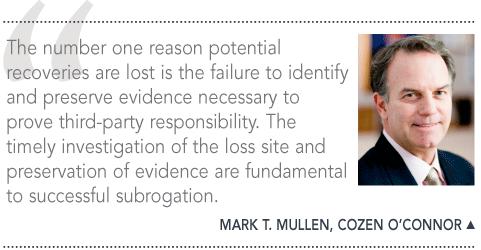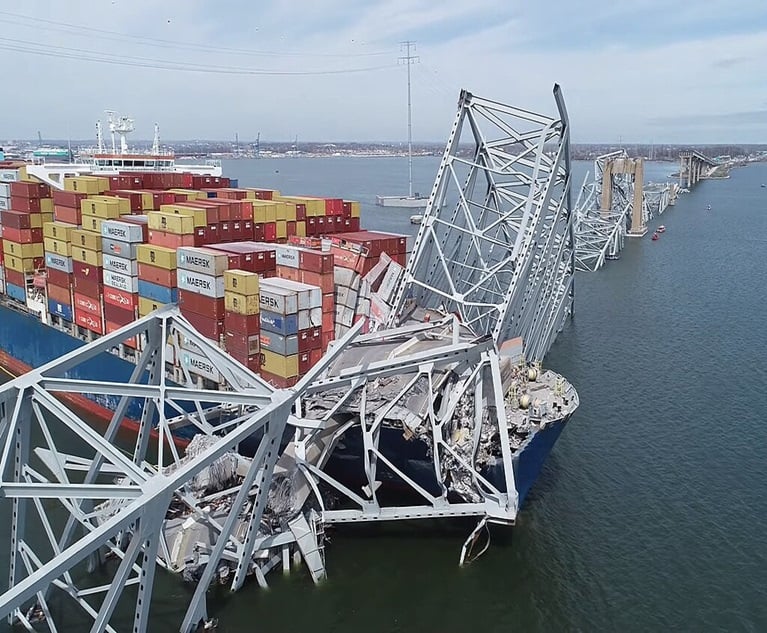Subrogation has its roots in the equitable notion that the partywho in good conscience is responsible for a loss should pay for theloss. Property insurance policies provide the natural opportunityfor accomplishing that goal when a loss is caused by a third partyand, absent insurance, that third party is liable under the law forthe damage caused to the injured party.
|Property insurers handle thousands of claims per year, and mostof them will not involve potential third-party responsibility.Nevertheless, claims professionals must remain vigilant as a missedsubrogation opportunity on any loss, especially a large loss,impacts recoveries. Using a hypothetical loss with certain factswill help us demonstrate how subrogation can be the land of missedopportunity.
|Old School v. New School
|There is a large fire at a multi-tenant warehouse built in the 1960s thatcauses substantial damage to the building itself and all of thetenants. The fire occurred on a summer night during a severethunderstorm and there are reports in the news and on line that itwas caused by lightning. According to the reports, the firechief stated that the fire spread rapidly and the local firedepartment had to pull out of the building and take a defensive“surround and drown” approach to keep the neighboring buildingsfrom catching fire.
|The fire marshal reported that witnesses stated there waslightning in the area during the fire. One of the tenants in thebuilding is insured by Old School Insurance Company. Another tenantis insured by New School Insurance Company. Both tenants promptlyreport the loss to their property insurance carriers. The insurerstake opposite approaches.
|The adjuster for Old School is pre-occupied from the outset byan aggressive insured and an even more aggressive public adjuster(PA). He is responding to the insured and the PA so he quicklylooks at the news reports, goes to the loss scene, interviews theinsured owner, and advises the company that he does not think thereis any subrogation. He bases that recommendationon the reports that lightning caused the fire (and you cannotsubrogate against God), the building is more than 50years old (so there are likely statute of repose issues) and thelease appears to have contractual provisions—suchas exculpatory clauses or waivers ofsubrogation—that will limit or preclude recovery.As a consequence of all of the above, he does not see anysubrogation prospects or the need to hire an expert. Thecompany agrees and closes the subrogation investigation.
The adjuster for New School decides to immediately retain anorigin and cause investigator and subrogation counsel to handle thepotential third-party liability issues while he focuses on theadjustment. The following possibilities demonstrate theconsequences for the two different paths chosen by theinsurers.
|Consider Subrogation Immediately
|By not hiring an independent origin and cause expert directly,or through counsel, Old School has failed to timely investigate theloss and potentially lost the opportunity to identify and preserveevidence. Public sector fire investigators can be an assetdepending upon their findings in a particular case, but the prudentcourse of action is to retain independent investigators as early aspossible. The number one reason potential recoveries are lost isthe failure to identify and preserve evidence necessary to provethird-party responsibility. The timely investigation of the losssite and preservation of evidence are fundamental to successfulsubrogation. The fire itself altered the scene and the evidence,but an early, detailed, and coordinated investigation to determinewhat happened, place potential parties on notice so they canparticipate, and to identify and preserve key evidence are crucialfirst steps.
|Retain the Right Experts
|The experts must be qualified. The only thing worse than noinvestigation is a poor one. Almost all fire cases start withorigin and cause experts. The National Fire ProtectionAssociation (NFPA) publishes a guide for fire and explosions, NFPA921, with which competent investigators, both private and publicsector, must be familiar. Other, more specialized, expertssuch as electrical engineers, mechanical engineers, materialsengineers, etc. can and should be brought in as needed once thecause is determined. Twenty years ago, theUnited States Supreme Court changed the landscape for experttestimony. Any expert retained may face challenges to his or hercredentials and methodology if the case proceeds to litigation infederal or state court. Taking the proper steps early canalleviate potential problems later after significant resources havebeen spent.
|Place Parties on Notice
|As soon as it becomes apparent that there are potentiallyresponsible parties involved, they should be put on notice andgiven a reasonable time to view the scene. Most cases will involvesome level of initial investigation to identify potentiallyresponsible parties but the longer you wait to place them on noticethe greater risk you run of a charge that you altered or spoiledthe evidence and are subject to possible sanctions. Whileevery case is different, the closer the scene is to the way youfound it, the better.
|All lawyers in the country involved in litigation are aware ofthe word “spoliation.” The doctrine has exploded in the last30 years. Research discloses that from 1970 to 1980 less than100 judicial opinions mentioned that term. From 1980 to 1990,it grew slowly to 147 opinions. From 1990 to 2000, it jumpedto 887 opinions and from 2000 to 2010, it exploded to 4,257judicial opinions where “spoliation”was mentioned.
|Identify and Preserve Evidence
|The final step in this critical first stage is identifying andpreserving the relevant evidence to prove your theory. It also may haveto include the other potential sources of ignition excluded by yourexpert or the fire marshal as the cause of the fire. Photographs and videotape of the scene as first found and duringthe investigation are important but may not substitute for actualnotice to a defendant if the defendant can prove it should havebeen placed on notice before the scene was altered.
|Issues can—and will—arise about what evidenceshould or must be preserved and who will bear thecosts. Attention should be placed on chain of custody toreduce the risk that an opponent can raise about the evidence'sauthenticity. Working through the issues is better thanignoring them and hoping to avoid a spoliation motion or sanctions.
|Navigate Legal Hurdles
|Contracts, including lease agreements, often contain clausesthat attempt to preclude or limit claims against one or bothparties to the contract. In many cases, the limitationlanguage, exculpatory clause, or waiver of subrogation may well apply. Nevertheless, thelanguage must be carefully reviewed as such contractual attempts toreduce or eliminate responsibility are not favored by the law andmay be avoided or circumvented if the proper language is not used,then the party attempting to enforce the terms itself hasviolated the agreement, there is gross negligence or other specialcircumstances.
|Obtaining all the relevant documents such as contracts andwarranties is an important part of the process for gatheringevidence and there will be cases that cannot be pursued because ofsuch contractual limitations. The decision whether to foregosubrogation should be made after all of the relevant documents areobtained and reviewed in the context of the facts that gave rise tothe incident.
|Explore All Theories
|There are cases where the initial cause of the loss cannot bedetermined or, if determined, is not the responsibility of athird-party but there is evidence that the fire should have beencontained such that there is a potential claim for itsspread. Such cases typically involve fires with alarm orsprinkler issues, storage or use of combustible or highly flammablematerials, failure to follow applicable building codes, or failureto properly take care of a vacant building or area of abuilding. It may not be necessary to prove how the firestarted in such cases but that the fire damage would have been lessif the potential defendant had acted reasonably.
|With respect to alarm or extinguishing systems, it is evenpossible that the fire may have been the fault of the plaintiff butthe proper operation of the system would have resulted in a smallfire with minimal damage rather than the catastrophe that ensuedbecause of the failure of the extinguishing system. All potentialtheories of liability for a large loss should be explored, whichinclude the enhancement or spread of the damages even if the causeof the loss is undetermined or not the responsibility of a thirdparty.
|Is There Potential Subrogation?
|Returning to our hypothetical, it turns out that theinvestigation performed by New School's origin and causeinvestigator revealed that while constructed in the 1960s, thewarehouse was converted to its present use nine years ago by areputable general contractor. The fire started in the space ofa tenant whose employees were operating a new machine, notlightning. There had been issues with the fire detection andsprinkler systems in that tenant's space which had been brought tothe attention of the landlord.
|The fire spread rapidly because of issues with the sprinklersystem and wall coverings that may not have been properly treatedwere in that space. As a result of the investigation, NewSchool placed the following parties on notice of a potential claim and invited them to the loss site: thelandlord, the tenant where the fire started, the manufacturer ofthe machine being used, the general contractor of the conversion ofthe building, and the contractor who installed the wallcoverings.
|A date was set after all parties were placed on notice foranyone who was interested, or their liability carrier, to sendrepresentatives to the loss scene to take photographs and identifyany evidence that party wanted to preserve. Arrangements werethereafter made to have electrical engineers examine the machinefor a potential product defect. Samples of the wall coveringswere retained and exemplars obtained for testing. Numerousphotographs and videos were taken of the loss scene and theevidence during the inspections.
|There is no guarantee that New School Insurance Company willobtain a subrogation recovery by way of settlement or a verdictbased upon the above facts but Old School Insurance Company likelymissed its chance at a potential recovery.
Want to continue reading?
Become a Free PropertyCasualty360 Digital Reader
Your access to unlimited PropertyCasualty360 content isn’t changing.
Once you are an ALM digital member, you’ll receive:
- All PropertyCasualty360.com news coverage, best practices, and in-depth analysis.
- Educational webcasts, resources from industry leaders, and informative newsletters.
- Other award-winning websites including BenefitsPRO.com and ThinkAdvisor.com.
Already have an account? Sign In
© 2024 ALM Global, LLC, All Rights Reserved. Request academic re-use from www.copyright.com. All other uses, submit a request to [email protected]. For more information visit Asset & Logo Licensing.








